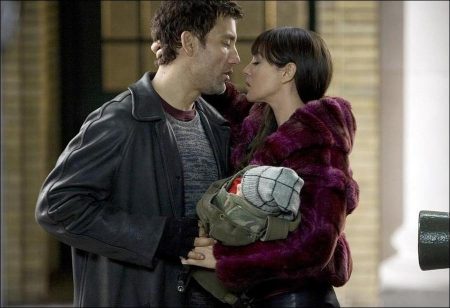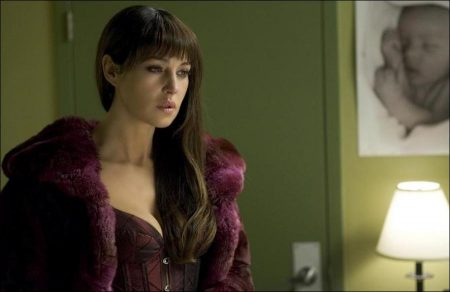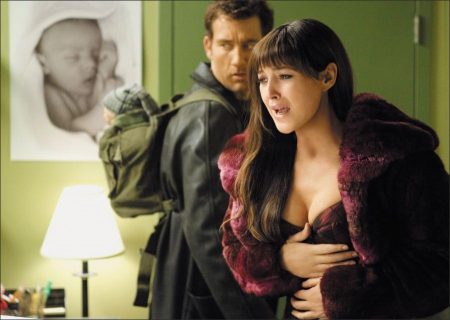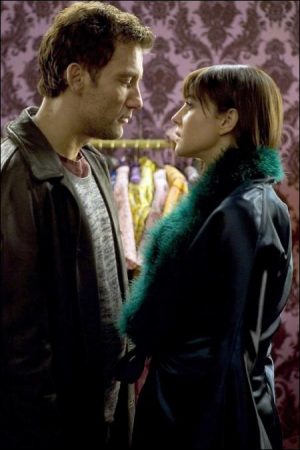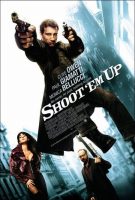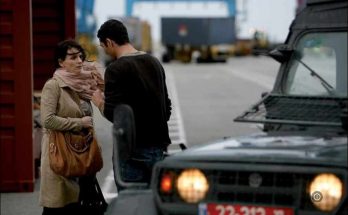Tagline: No name, no past, nothing to lose.
Shoot ‘Em Up movie storyline. Late at night, in an unnamed U.S. city, a solitary man sits at a bus stop. A pregnant woman runs by, pursued by a man with a gun. With reluctance, the man at the bus stop rescues her and assists with the baby’s delivery, while additional pursuers fire at them, including the gang’s particularly nasty leader, an intuitive man named Hertz.
Our hero, known only as Smith, determines to save the child and find out why Hertz wants the baby dead. At a local bordello, he tries to employ a lactating hooker to watch the child, but things quickly escalate, and this makeshift family is soon on the run. Heavy metal music calms the baby. Why? A laboratory, gun factory, and presidential campaign all figure in Smith’s quest for the child’s safe deliverance.
Shoot ‘Em Up is a 2007 gun fu action film written and directed by Michael Davis. Starring Clive Owen, Paul Giamatti, Monica Bellucci and Stephen McHattie, it follows Smith (Owen), a drifter who rescues a newborn from being killed by assassin Hertz (Giamatti) and his henchmen. Smith flees from the gang, enlisting the help of prostitute D. Q. (Bellucci) to keep the baby safe as he unravels the conspiracy.
The film was produced by Susan Montford, Don Murphy and Rick Benattar under Murphy’s film banner Angry Films. The film was released on September 7, 2007 and underperformed at the box office. It opened in fourth place on its first weekend, earning $5,716,139 at 2,108 locations. The film was a box office bomb, having earned a worldwide gross of $26,820,641 against a $39 million budget.
About the Production
The genesis of Shoot ‘Em Up was sparked by a scene from John Woo’s Hardboiled where the hero, played by Chow Yun Fat, is in a hospital with a gun and a baby.
“Putting together a hardboiled guy with the most innocent thing in the world delivers dramatic tension and a great image,” says writer/director Michael Davis, whose awardwinning films include Eight Days a Week and 100 Girls. Davis expanded upon this scenario and devised the idea of having a gun fight in the middle of a room while the hero is helping to deliver a baby. “I thought it would be a great opening for a movie,” states the imaginative director.
Shoot ‘Em Up is akin to an American John Woo action movie and tells the story of the angriest man in the world, Mr. Smith, who’s stuck with a baby and a life-threatening situation,” continues Davis, who also wrote the original screenplay. “It’s about all the imaginative and clever things you can do with a gun fight.”
“The easy bit was plotting all the cool things you can do with a gun fight,” says Davis, a former storyboard artist who came up with a series of unique and outlandish scenarios in which to stage elaborate “shoot ‘em ups.” In addition to the birth sequence shoot-out which opens the film, there’s a gun fight while Smith and paratroopers are free-falling out of an airplane, a scene where Smith spins a playground carousel with bullets so a sniper can’t shoot the baby lying on it, and, in the perfect distillation of sex and violence, a sequence where Smith and the his accomplice, the prostitute DQ, make love during a gun fight.
The John Woo film was one inspiration. But the seeds for Shoot ‘Em Up were sown several decades earlier when Davis was a 6th grader writing his own 100-page James Bond novels on a typewriter, with titles such as Masquerade of Death and Spearhead which mimicked the Ian Fleming tone.
“I’ve been dreaming of doing an all-out action movie since then, whether it was writing my childhood novels or now, animating and writing a script,” says Davis, who drew 17,000 drawings to create 15 minutes of animation for the film’s 11 action sequences to use as a sales tool, which proved to be effective, impressing the producers – Susan Montford, Don Murphy and Rick Benattar (who, like Davis, is himself a Bond fanatic) – New Line Cinema executives and, ultimately, the cast.
“The animation really encapsulated the high energy of the picture. It’s been very exciting to see that process of drawn vision translated to the real vision on film,” adds Davis.
Hollywood is an ephemeral place. You can be the most gifted screenwriter in town, but if you don’t get that break, you’re still a struggling filmmaker. Divine intervention intervened for Davis when his acquaintance from their days at University of Southern California, producer Don Murphy (Transformers, Natural Born Killers, League of Extraordinary Gentlemen), along with his partners, Susan Montford and Rick Benattar, took up the cause.
“We felt Shoot ‘Em Up was this truly special script with a unique voice begging to be made. It was right up our alley because it pokes fun at America’s big obsessions – guns and breasts and violence, in that order,” says Don Murphy, whose company, Angry Films, worked with Davis on his presentation showing the director’s vision for the action sequences in the film as well as a line-drawn trailer. “We sent this stunning DVD animatic to New Line Cinema as our first choice and they loved it,” adds Susan Montford.
Executives at New Line Cinema saw the potential in the film after viewing Davis’ animatic and pitched it to the studio heads, who gave the green light. “New Line made sure that we were able to cast and hire the great people we have,” says Murphy. “Michael had a vision and passion for the script as evidenced in the animatic. We felt this was the movie he was born to direct.” Davis finally got his break.
Michael Davis describes Shoot ‘Em Up as a “blue-collar James Bond movie. Mr. Smith is the antithesis of James Bond. He has been psychologically damaged in his past and is homeless, which gives you a Rocky-like underdog feeling, because he has no resources but his own. He lives in a derelict building. He’s got nothing. Bond has all these gadgets.
Mr. Smith’s only talent is shooting, so he eats carrots because they’re good for eyesight. And he has a pet rat trained to unlock his door – all low tech.” Smith is also ingenious. “I like to see the clever way the guy gets out of a tough situation, what his thought process is. I find that much more exciting than the big spectacle, because it’s the idea that’s being celebrated,” adds Davis, who from the start set out to make a highly visceral film punctuated with witty dialogue.
Producer Susan Montford’s perspective on the picture: “If you love cinema you will love this film – it references the spaghetti westerns of Sergio Leone, the French gangster movies of Melville and of course John Woo. The lead characters are cinematic archetypes re-imagined through Michael Davis’ very twisted imagination. DQ is the tragic prostitute/mother. Smith is the mythic hardboiled loner with a slew of witty one-liners.
They are classic outsiders doing whatever it takes to survive. When along comes this baby and brings them together, throwing both their lives into disarray. They join together to save the baby from Hertz, the fetishistic gangster with glasses and a comb-over. Like the BTK Killer, you could almost mistake him for a regular family man.”
When it came time to assemble the dream cast, Michael Davis’ top choice for the role of Mr. Smith was Clive Owen, best known for his work in Sin City and Inside Man. “Clive’s a straight-up action hero, but we never thought for a moment we’d get him,” says Davis. But Owen, who co-incidentally had just turned down another film, was keen to play Mr. Smith. He and Davis met, hit it off and, as they say in the UK, ‘Bob’s your uncle!’ They decided that Owen would play the off-beat character with an English accent, because the British have a knack for dark witty humor. “He’s a little bit tougher with the British accent,” explains Davis.
“Clive brings a very mysterious brooding quality to Mr. Smith. He’s also done a lot of his own stunts and action as well. He’s really brilliant. You can’t take your eyes off him,” adds producer Susan Montford. “Mr. Smith is the angriest man in the world,” says Michael Davis. “Because he’s angrier at a bigger thing that has caused trouble in his life, it’s all the little things in life that make him angry. He verbalizes all the small things that irritate any one of us in real life – someone chewing gum, a guy who doesn’t use his turn signals, or someone slurping coffee. He’s hardboiled, but we can identify with him. A back story hints as to why he’s homeless, why he has these great abilities. Not only does the movie have a mystery structure, plot-wise, as to why the bad guys are trying to kill the baby, but there is a progression as to who this character is. Although he comes across as sarcastic and angry, the irony is that he’s the most sensitive guy in the movie. That’s why all these things bother him so much – because he is so sensitive.”
Clive Owen concurs, “Smith says he hates everything, but he doesn’t really. It annoys him when people try to kill him. It winds him up and he can be pretty ruthless at times. But ultimately he always finds a way and deals with the situations.”
Playing the key role of DQ, the prostitute whom Smith enlists to help him care for and protect the newborn baby, is Italian actress Monica Bellucci. “Monica is an incredibly beautiful, soulful actor with a refreshing lack of inhibition,” says producer Susan Montford. “Once we imagined her as DQ we couldn’t envision anyone else.”
Echoes Michael Davis, “Monica is great for the part because I needed a strong personality to interact with Smith’s strong personality. She’s also very sexy and is the only character in the movie that doesn’t take crap from Smith. She calls him on everything. What’s also great about Monica is that in Italian families, the matriarch is such a strong figure. Her name is Donna Quintana, but Smith calls her DQ for short. She’s really the emotional core at the center of the movie. She’s always honest, she’s always saying what she’s feeling and eventually she gets Smith to make a transformation, to be a bit more open and caring, to start healing from his emotional wounds.”
Bellucci was attracted by the originality of the script and the mix of different elements. “Shoot ‘Em Up is violent, it’s rock n’ roll, sexy, dark, scary but human with a lot of humor. It’s difficult to find all those elements together,” says the actress, who was also drawn to the unconventional love story. “When the film starts, neither Smith nor DQ know how to love or what love means. Through the baby, who accidentally comes into their lives, they realize who they truly are; and through giving to the baby they also learn how to love each other.” Bellucci also loved the character of DQ. “She’s a hooker with a specialty, something very kinky. I loved playing her because she’s totally free. She does dangerous, dark dirty things in a playful way.”
Some years before, Michael Davis had written a screenplay about Alfred Kinsey. “Because I’d done all this research on human sexuality, all my scripts became more influenced with so many great things about sex. I never would’ve written about a lactating hooker if I hadn’t written the Kinsey script. In Shoot ‘Em Up, the hero is stuck with a baby. Who would he go to for help? Why not go to this woman who can actually feed the baby? DQ’s the perfect foil for Smith because she helps. Just as Smith seems like he’s had something in his life that’s shattered him, she too has had something that shattered her. A really strong love story develops about these two broken people who come together and form this makeshift family, making the story stronger.
“Monica’s a terrific actress and has done some incredible work,” says Clive Owen. “In the film we obviously have a history – I go to her for help because the baby needs to be fed. We have a very tough relationship, but you can tell really that we’re very fond of each other. She’s very nurturing towards the baby and we make a very weird little family unit.”
Paul Giamatti plays the chief bad guy, Hertz, who is relentlessly prowling after Smith. “What I found interesting about bad guys is that they’re not bad guys 24 hours a day,” says Michael Davis. “They don’t think that they’re bad guys, so how could I make a bad guy character feel like he’s not a bad guy? Consequently, throughout the story, Hertz is always calling home and talking to his wife as if his job is a Wall Street broker. He just has to work late. You get this family man side contrasting with this horrible violent guy.”
“A thriller is only as good as your bad guy,” continues Davis. “So I didn’t want to play it safe with Hertz. I needed an actor who could pull if off and became intrigued with the idea of Paul. The idea grew on me because it’s against type. Though he’s not physically big as a villain, mentally he is. It made it more fun that Hertz can represent everything about him as big: he has a big gun, drives a big car, has a big belt buckle and he’s also compensating for his size. You need a great actor to pull off somebody’s that a little bit more dimensional.”
“Paul usually plays angst-ridden characters and now he gets to play a straight-forward bad guy, whom he modeled on the BTK Killer. He’s very funny and creepy as well,” says producer Susan Montford.
Giamatti, who had never played a bad guy or fired a gun before, gleefully reveals why he wanted to do the film. “There’s a kind of Gestapo scene near the end where I break all of Smith’s fingers. When I first read the script, I really wanted to do that scene. It goes on forever and I really break each one of his fingers nice and slowly. It was a fun scene to do. I try to kill his spirit. I’m more about killing people’s souls. I have one great scene where I get to torture Monica Bellucci. She was great to torture. She’s fantastic and an incredibly interesting actress.”
Adds Giamatti about his character, “I play an FBI profiler gone bad who’s a superintuitive genius. The idea was to have a non-traditional bad guy so we came up with the idea of making him look like an accountant. To all outward appearances, Hertz is a bland nobody little guy. Michael wanted to have a guy who kills people but has a family life back home. I have sweet conversations with my wife in the midst of incredible violence. It’s when Hertz shoots someone in the head that he’s actually kind of happy,” laughs the actor. “It’s nothing but big, cool scenes of people shooting each other.”
Giamatti was so enthusiastic about his character’s look, he entreated his hair stylist to shave the crown of his head, leaving some long strands to comb over, and he framed his face with a beard. His stylist topped it off with a ‘greasy’ look, with a bit of help from Brillcream.
No action film, especially one as extreme as Shoot ‘Em Up, would be complete without guns, which constituted a large part of the shoot. Weapons Specialist Charles Taylor was able to provide approximately 80 different weapons. “Clive handles 18 different guns when he takes out the bad guys. Hertz is a little man with a big pistol – 50 caliber Desert Eagle. Hertz’ gang carries a mixture of standard guns from hand guns to machine guns. Hammerson and Lone Man use higher end custom-made sub machine guns and machine guns,” says Taylor, who, before principal photography, tutored Clive Owen and Paul Giamatti at an indoor range training facility where they learned basic gun safety, gun handling on set and advanced tactical weapons training – CQB (Close Quarters Battle).
“Basically I taught the actors how to handle firearms close to an assailant; how to engage a target while moving and advanced weapons tactics because the director, who selected the guns for each character, wanted Clive Owen to be doing some pretty spectacular things and be well versed in urban combat,” says Taylor, whose weapons were all been modified to fire blanks. He estimates that more than 25,000 rounds of blanks were fired throughout the shoot.
One of Taylor’s guns was so technologically advanced that it could only be fired by the owner’s thumbprint. Thus, in one wrenching scene, Smith has to sever the hand off a dead assailant in order to use his thumbprint to fire the pistol.
They worked out that 85 people would be killed in the movie. In some scenes there were from 150-200 pyrotechnic squibs set up at one time, requiring multiple retakes and different sizes, sometimes combining blowing a hole with a spark or adding blood bags. A squib is a small explosive device which punches out whatever you put it behind. Chilver’s challenge was making it look real without it doing the kind of damage that the real thing would normally do. Actors and stuntmen are protected by a metal plate placed behind the device. The magic of CGI adds hundreds more bullet hits.
“I think we spent most of my expendable budget on squibs,” says Chilvers, who estimates that 6,000 squibs were used throughout the shoot along with 15 gallons of blood. “I think we’ve used more blood on this movie than I’ve used on most of the other movies I’ve done put together!”
Shoot ‘Em Up (2007)
Directed by: Michael Davis
Starring: Clive Owen, Monica Bellucci, Paul Giamatti, Stephen McHattie, Greg Byrk, Daniel Pilon, Ramona Pringle, Chris Jericho, Jane McLean, Ramona Pringle, Stephen R. Hart
Screenplay by: Michael Davis
Production Design by: Gary Frudkoff
Cinematography by: Peter Pau
Film Editing by: Peter Amundson
Costume Design by: Denise Cronenberg
Music by: Paul Haslinger
MPAA Rating: R for pervasive strong bloody violence, sexuality and some language.
Distributed by: New Line Cinema
Release Date: September 7, 2007
Views: 120
